Physical and Mechanical Properties of All-Solid-Waste-Based Binder-Modified Abandoned Marine Soft Soil
Abstract
:1. Introduction
2. Materials and Methods
2.1. Test Materials
2.1.1. Test Soil
2.1.2. CGF and Cement
2.2. Testing Program
2.2.1. Factors Affecting the Performance of Modified Soils
2.2.2. Testing Program
2.3. Specimen Preparation
3. Results
3.1. Physical Properties Tests
3.2. Standard Proctor Tests and Unconfined Compressive Strength Tests
3.3. XRD Analysis and SEM Analysis
4. Discussion
4.1. Physical Properties of Modified Soil
4.2. Compaction and Mechanical Properties of Modified Soils
4.2.1. Compaction Properties of Modified Soils
4.2.2. Deformation Properties of Compacted Modified Soils
4.2.3. Strength Properties of Compacted Modified Soils
4.3. Microscopic Modification Mechanism
4.4. Quantitative Evaluation for Environmental and Economic Benefits
5. Conclusions
- The water content of marine soft soil decreased from 38% to ranges between 37.13% and 34.41% within 1 d after the addition of the binder. This reduction in water content can be attributed to both physical mixing and chemical reactions. Specifically, the water content reduction stemming from physical mixing remained unchanged irrespective of the compaction delay time, whereas the reduction due to chemical reactions progressively increased with compaction delay time, tending to stabilize after 7 d. Under conditions of 8% binder content and 0 d compaction delay, the plasticity index of CGF-modified soil decreased from 22.5 to 21.4, while that of cement-modified soil decreased to 21.3. The liquid limit increased for CGF-modified soil and decreased for cement-modified soil. Additionally, as the binder content increased, the plasticity index of the modified soil gradually decreased. Meanwhile, the liquid limit and plastic limit of CGF-modified soil showed an increasing trend, whereas those of cement-modified soil decreased.
- After the addition of 2% CGF, the optimum moisture content of marine soft soil increased from 18.56% to a range between 18.95% and 23.25%. Simultaneously, the dry density decreased from 1.70 g/cm3 to a range between 1.57 g/cm3 and 1.66 g/cm3 during the compaction delay. With increasing binder content, the optimum moisture content of the CGF-modified soil gradually rose while the maximum dry density decreased. Conversely, the cement-modified soil exhibited an opposing trend. Additionally, as the compaction delay time increased, the optimum moisture content of the CGF-modified soil gradually rose, while that of the cement-modified soil showed a slight decrease. Meanwhile, the maximum dry density of both modified soils displayed a decreasing trend with the increase in compaction delay time.
- There exists a linear relationship between the strength and deformation modulus of CGF-modified and cement-modified soils. For the seven-day compaction delayed modified soils, the strength increases initially and then decreases with the rise in binder content, with the optimal content varying between 4% and 6% for different moisture content ratios of the compacted modified soils. Under constant binder content, the strength variation is influenced by the initial water content as the compaction delay time (t1) increases. Meanwhile, with an increase in the curing time (t2), there is a consistent upward trend in the strength of the modified soils.
- The process of CGF modification on marine soft soil in Jiaozhou Bay can be segmented into three stages: the formation of modified soil, the formation of compacted modified soil, and the curing of compacted modified soil. The modification mechanisms primarily involve the alkali excitation reaction of CGF, the pozzolanic reaction, the ion-exchange reaction between CGF and clay minerals, and the carbonization reaction.
- After calculation, both the carbon footprint and cost per unit strength of CGF are significantly lower than that of cement.
Author Contributions
Funding
Institutional Review Board Statement
Informed Consent Statement
Data Availability Statement
Acknowledgments
Conflicts of Interest
References
- Zhu, W.; Zhang, C.L.; Gao, Y.F.; Fan, Z.P. Fundamental mechanical properties of solidified dredged marine sediment. J. Zhejiang Univ. (Eng. Sci.) 2005, 39, 1561–1565. [Google Scholar]
- Wang, D.X.; Abriak, N.E.; Zentar, R.; Xu, W. Solidification/stabilization of dredged marine sediments for road construction. Environ. Technol. 2012, 33, 95–101. [Google Scholar] [CrossRef]
- Rajasekaran, G.; Narasimha Rao, S. Compressibility behaviour of lime-treated marine clay. Ocean Eng. 2002, 29, 545–559. [Google Scholar] [CrossRef]
- Kang, G.; Tsuchida, T.; Athapaththu, A. Engineering behavior of cement-treated marine dredged clay during early and later stages of curing. Eng. Geol. 2016, 209, 163–174. [Google Scholar] [CrossRef]
- Crocetti, P.; González-Camejo, J.; Li, K.; Foglia, A.; Eusebi, A.L.; Fatone, F. An overview of operations and processes for circular management of dredged sediments. Waste Manag. 2022, 146, 20–35. [Google Scholar] [CrossRef]
- Yu, C.Y.; Yuan, J.; Cui, C.Y.; Zhao, J.Y.; Liu, F.; Li, G. Ontology Framework for Sustainability Evaluation of Cement-Steel-Slag-Stabilized Soft Soil Based on Life Cycle Assessment Approach. J. Mar. Sci. Eng. 2023, 11, 1418. [Google Scholar] [CrossRef]
- Khalid, U.; Liao, C.C.; Ye, G.-L.; Yadav, S.K. Sustainable improvement of soft marine clay using low cement content: A multi-scale experimental investigation. Constr. Build. Mater. 2018, 191, 469–480. [Google Scholar] [CrossRef]
- Zentar, R.; Wang, H.; Wang, D. Comparative study of stabilization/solidification of dredged sediments with ordinary Portland cement and calcium sulfo-aluminate cement in the framework of valorization in road construction material. Constr. Build. Mater. 2021, 279, 122447. [Google Scholar] [CrossRef]
- Zhang, R.J.; Santoso, A.M.; Tan, T.S.; Phoon, K.K. Strength of High Water-Content Marine Clay Stabilized by Low Amount of Cement. J. Geotech. Geoenviron. Eng. 2013, 139, 2170–2181. [Google Scholar] [CrossRef]
- Raja, P.S.K.; Thyagaraj, T. Significance of compaction time delay on compaction and strength characteristics of sulfate resistant cement-treated expansive soil. J. Rock Mech. Geotech. Eng. 2021, 13, 1193–1202. [Google Scholar] [CrossRef]
- Zhang, T.J.; Ding, J.W.; Deng, D.S.; Hong, Z.S. Change law of water content of dredged clays treated by quick lim. Rock Soil Mech. 2009, 30, 2775–2778+2791. [Google Scholar] [CrossRef]
- Zhu, W.; Zhang, C.L.; Chiu, A.C.F. Soil-Water Transfer Mechanism for Solidified Dredged Materials. J. Geotech. Geoenviron. Eng. 2007, 133, 588–598. [Google Scholar] [CrossRef]
- Federico, A.; Vitone, C.; Murianni, A. On the mechanical behaviour of dredged submarine clayey sediments stabilized with lime or cement. Can. Geotech. J. 2015, 52, 2030–2040. [Google Scholar] [CrossRef]
- Chew, S.H.; Kamruzzaman, A.H.M.; Lee, F.H. Physicochemical and engineering behavior of cement treated clays. J. Geotech. Geoenviron. Eng. 2004, 130, 696–706. [Google Scholar] [CrossRef]
- Celik, E.; Nalbantoglu, Z. Effects of ground granulated blastfurnace slag (GGBS) on the swelling properties of lime-stabilized sulfate-bearing soils. Eng. Geol. 2013, 163, 20–25. [Google Scholar] [CrossRef]
- Liu, F.; Zhu, C.; Yang, K.; Ni, J.; Hai, J.; Gao, S. Effects of fly ash and slag content on the solidification of river-dredged sludge. Mar. Georesources Geotechnol. 2019, 39, 65–73. [Google Scholar] [CrossRef]
- Al-Rawas, A.A.; Hago, A.W.; Al-Sarmi, H. Effect of lime, cement and Sarooj (artificial pozzolan) on the swelling potential of an expansive soil from Oman. Build. Environ. 2005, 40, 681–687. [Google Scholar] [CrossRef]
- Deng, D.S.; Zhang, T.J.; Zhang, S.; Hong, Z.S. Technique for utilization of high-water-content dredged clayey soil as fill material for the Eastern Route of South-to-North Water Diversion Project. J. Hohai Univ. (Nat. Sci.) 2008, 4, 559–562. [Google Scholar]
- Horpibulsuk, S.; Rachan, R.; Chinkulkijniwat, A.; Raksachon, Y.; Suddeepong, A. Analysis of strength development in cement-stabilized silty clay from microstructural considerations. Constr. Build. Mater. 2010, 24, 2011–2021. [Google Scholar] [CrossRef]
- Yilmaz, Y.; Ozaydin, V. Compaction and shear strength characteristics of colemanite ore waste modified active belite cement stabilized high plasticity soils. Eng. Geol. 2013, 155, 45–53. [Google Scholar] [CrossRef]
- Di Sante, M. On the Compaction Characteristics of Soil-Lime Mixtures. Geotech. Geol. Eng. 2019, 38, 2335–2344. [Google Scholar] [CrossRef]
- Moghal, A.A.B.; Ashfaq, M.; Al-Obaid, A.; Abbas, M.F.; Al-Mahbashi, A.M.; Shaker, A.A. Compaction delay and its effect on the geotechnical properties of lime treated semi-arid soils. Road Mater. Pavement Des. 2021, 22, 2626–2640. [Google Scholar] [CrossRef]
- Bourokba Mrabent, S.A.; Hachichi, A.; Souli, H.; Taibi, S.; Fleureau, J.-M. Effect of lime on some physical parameters of a natural expansive clay from Algeria. Eur. J. Environ. Civ. Eng. 2015, 21, 108–125. [Google Scholar] [CrossRef]
- Khattab, S.A.A.; Al-Mukhtar, M.; Fleureau, J.M. Long-term stability characteristics of a lime-treated plastic soil. J. Mater. Civ. Eng. 2007, 19, 358–366. [Google Scholar] [CrossRef]
- Chen, R.; Cai, G.; Dong, X.; Pu, S.; Dai, X.; Duan, W. Green utilization of modified biomass by-product rice husk ash: A novel eco-friendly binder for stabilizing waste clay as road material. J. Clean. Prod. 2022, 376, 134303. [Google Scholar] [CrossRef]
- Nazari, Z.; Tabarsa, A.; Latifi, N. Effect of compaction delay on the strength and consolidation properties of cement-stabilized subgrade soil. Transp. Geotech. 2021, 27, 100495. [Google Scholar] [CrossRef]
- Raja, P.S.K.; Thyagaraj, T. Effect of compaction time delay on compaction and strength behavior of lime-treated expansive soil contacted with sulfate. Innov. Infrastruct. Solut. 2020, 5, 14. [Google Scholar] [CrossRef]
- Su, X.T.; Yang, J.J.; Dong, M.R.; Wang, X.Q.; Jiao, D.C. Research on Engineering Properties of Cement Semi-solidified Soil. Period. Ocean Univ. China 2020, 50, 134–140. [Google Scholar] [CrossRef]
- Sullivan, W.G.; Howard, I.L. Time Delay Effects on Compactability of Soil-Cement Materials during Proctor Testing. Transp. Res. Rec. 2021, 2675, 481–493. [Google Scholar] [CrossRef]
- Horpibulsuk, S.; Miura, N.; Nagaraj, T.S. Clay-water/cement ratio identity for cement admixed soft clays. J. Geotech. Geoenviron. Eng. 2005, 131, 187–192. [Google Scholar] [CrossRef]
- Arman, A.; Saifan, F. The Effect of Delayed Compaction of Stabilized Soil-Cement. Highw. Res. Rec. 1967, 198, 30–38. [Google Scholar]
- Zhang, R.J.; Zheng, S.H.; Zheng, J.J. Experimental study on strength behavior of high water content clay stabilized by low amount of cement. J. Huazhong Univ. Sci. Technol. (Nat. Sci. Ed.) 2015, 43, 101–106. [Google Scholar] [CrossRef]
- Horpibulsuk, S.; Miura, N.; Nagaraj, T.S. Assessment of strength development in cement-admixed high water content clays with Abrams’ law as a basis. Geotechnique 2003, 53, 439–444. [Google Scholar] [CrossRef]
- Gui, Y.; Gao, Y.F.; Song, Z.W.; Cai, C. Strength variation rules of filling soil improved from high-water-content dredged sludge with quicklime during delay time. J. Hohai Univ. (Nat. Sci.) 2010, 38, 185–190. [Google Scholar]
- Yang, J.J.; Dong, M.R.; Sun, T.; Wang, M. Forecast formula for strength of cement-treated clay. Soils Found. 2019, 59, 920–929. [Google Scholar] [CrossRef]
- Yang, J.; Liu, H.; Liu, Q.; Dong, M.; Wang, M.; Mi, R. Prediction Formula For Unconfined Compressive Strength of Cement Treated Soft Soil During Full Age. Lowl. Technol. Int. 2019, 21, 143–150. [Google Scholar]
- Kamruzzaman, A.H.; Chew, S.H.; Lee, F.H. Structuration and Destructuration Behavior of Cement-Treated Singapore Marine Clay. J. Geotech. Geoenviron. Eng. 2009, 135, 573–589. [Google Scholar] [CrossRef]
- Li, S.; Wang, D.; Wu, Y. Strength and load-bearing behaviors of cement-industrial by-products solidified crust layer over soft subsoil. Constr. Build. Mater. 2024, 412, 134744. [Google Scholar] [CrossRef]
- Provis, J.L.; Bernal, S.A. Geopolymers and Related Alkali-Activated Materials. Annu. Rev. Mater. Res. 2014, 44, 299–327. [Google Scholar] [CrossRef]
- Haddad, R.H.; Alshbuol, O. Production of geopolymer concrete using natural pozzolan: A parametric study. Constr. Build. Mater. 2016, 114, 699–707. [Google Scholar] [CrossRef]
- Xie, T.; Ozbakkaloglu, T. Behavior of low-calcium fly and bottom ash-based geopolymer concrete cured at ambient temperature. Ceram. Int. 2015, 41, 5945–5958. [Google Scholar] [CrossRef]
- Wu, Y.; Yang, J.; Chang, R. The design of ternary all-solid-waste binder for solidified soil and the mechanical properties, mechanism and environmental benefits of CGF solidified soil. J. Clean. Prod. 2023, 429, 139439. [Google Scholar] [CrossRef]
- Wu, Y.; Yang, J.; Chang, R.; Li, S.; Kou, H. Strength, leaching characteristics and microstructure of CGF+P all-solid-waste binder solidification/stabilization Cu(Ⅱ) contaminated soil. Constr. Build. Mater. 2024, 411, 134431. [Google Scholar] [CrossRef]
- Zhang, P.; Wang, K.X.; Li, Q.F.; Wang, J.; Ling, Y.F. Fabrication and engineering properties of concretes based on geopolymers/alkali-activated binders—A review. J. Clean. Prod. 2020, 258, 120896. [Google Scholar] [CrossRef]
- Duxson, P.; Fernández-Jiménez, A.; Provis, J.L.; Lukey, G.C.; Palomo, A.; van Deventer, J.S.J. Geopolymer technology: The current state of the art. J. Mater. Sci. 2006, 42, 2917–2933. [Google Scholar] [CrossRef]
- Zhao, H.; Chu, H.; Ye, H.; Guo, K.L. Experimental Study on the Effects of Physical Propertiesof Expansive Soil Improved by Industrial Wast. Sci. Technol. Eng. 2017, 17, 230–235. [Google Scholar]
- Provis, J.L. 4-Activating solution chemistry for geopolymers. In Geopolymers; Provis, J.L., van Deventer, J.S.J., Eds.; Woodhead Publishing: Sawston, UK, 2009; pp. 50–71. [Google Scholar]
- Al-Azzawi, M.; Yu, T.; Hadi, M.N.S. Factors Affecting the Bond Strength Between the Fly Ash-based Geopolymer Concrete and Steel Reinforcement. Structures 2018, 14, 262–272. [Google Scholar] [CrossRef]
- GB/T50123; Standard of Geotechnical Test Method. Ministry of Housing and Urban-Rural Development: Beijing, China, 2019.
- GB5007; Code for Design of Building Foundation. Ministry of Housing and Urban-Rural Development: Beijing, China, 2011.
- Tang, Y.X.; Liu, H.L.; Zhu, W. Study on engineering properties of cement-stabilized soil. Chin. J. Geotech. Eng. 2000, 22, 549–554. [Google Scholar]
- Wu, Y.L. Development of All-solid-waste binders & Stabilization/Solidification mechanism of heavy metal and application in contaminated site soil. Ph.D. Thesis, Ocean University of China, Qingdao, China, 2022. [Google Scholar]
- Jongpradist, P.; Jumlongrach, N.; Youwai, S.; Chucheepsakul, S. Influence of Fly Ash on Unconfined Compressive Strength of Cement-Admixed Clay at High Water Content. J. Mater. Civ. Eng. 2010, 22, 49–58. [Google Scholar] [CrossRef]
- Pei, X.; Zhang, F.; Wu, W.; Liang, S. Physicochemical and index properties of loess stabilized with lime and fly ash piles. Appl. Clay Sci. 2015, 114, 77–84. [Google Scholar] [CrossRef]
- Garzón, E.; Cano, M.; O’Kelly, B.C.; Sánchez-Soto, P.J. Effect of lime on stabilization of phyllite clays. Appl. Clay Sci. 2016, 123, 329–334. [Google Scholar] [CrossRef]
- Kampala, A.; Jitsangiam, P.; Pimraksa, K.; Chindaprasirt, P. An investigation of sulfate effects on compaction characteristics and strength development of cement-treated sulfate bearing clay subgrade. Road Mater. Pavement Des. 2020, 22, 2396–2409. [Google Scholar] [CrossRef]
- Di Sante, M.; Fratalocchi, E.; Mazzieri, F.; Brianzoni, V. Influence of delayed compaction on the compressibility and hydraulic conductivity of soil-lime mixtures. Eng. Geol. 2015, 185, 131–138. [Google Scholar] [CrossRef]
- Cong, P.; Cheng, Y.; Ge, W.; Zhang, A. Mechanical, microstructure and reaction process of calcium carbide slag-waste red brick powder based alkali-activated materials (CWAAMs). J. Clean. Prod. 2022, 331, 129845. [Google Scholar] [CrossRef]


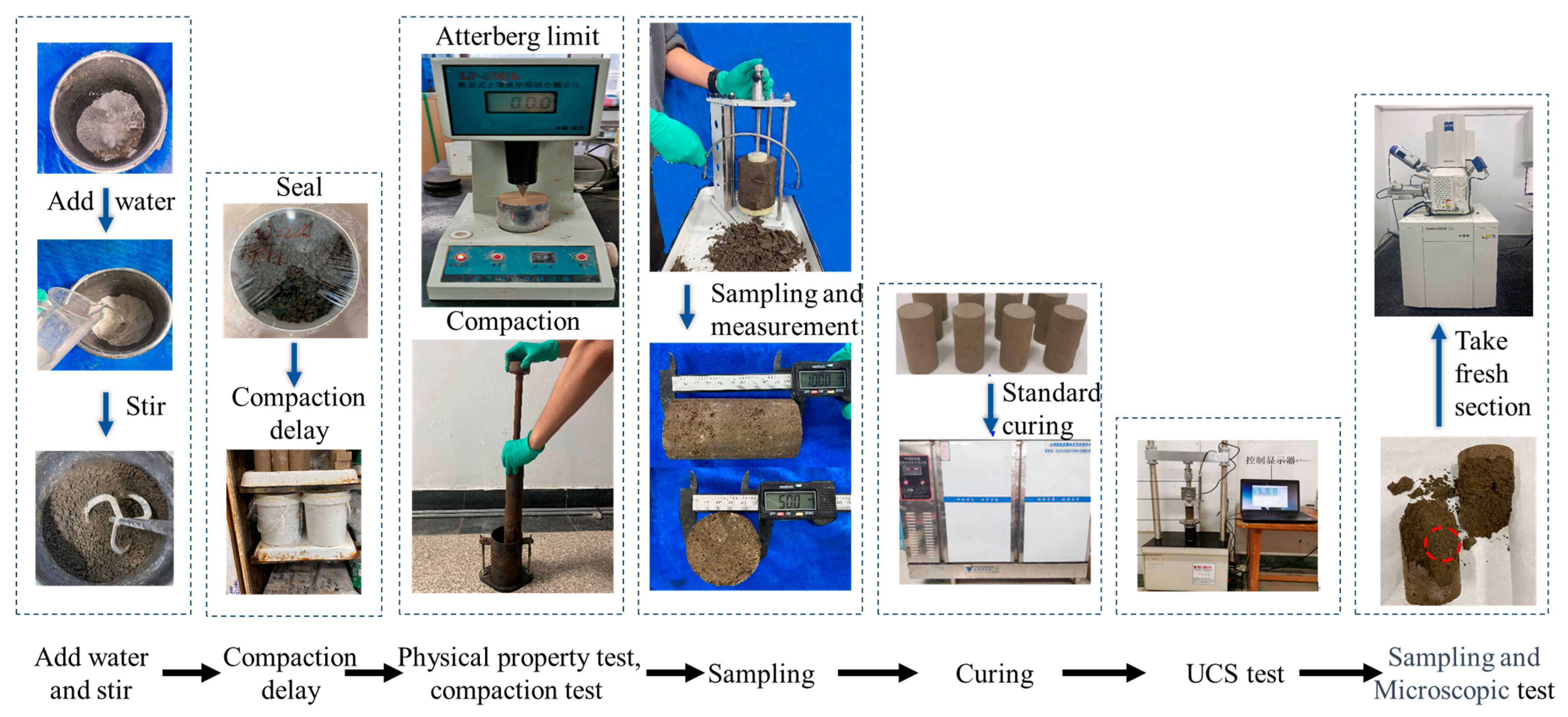


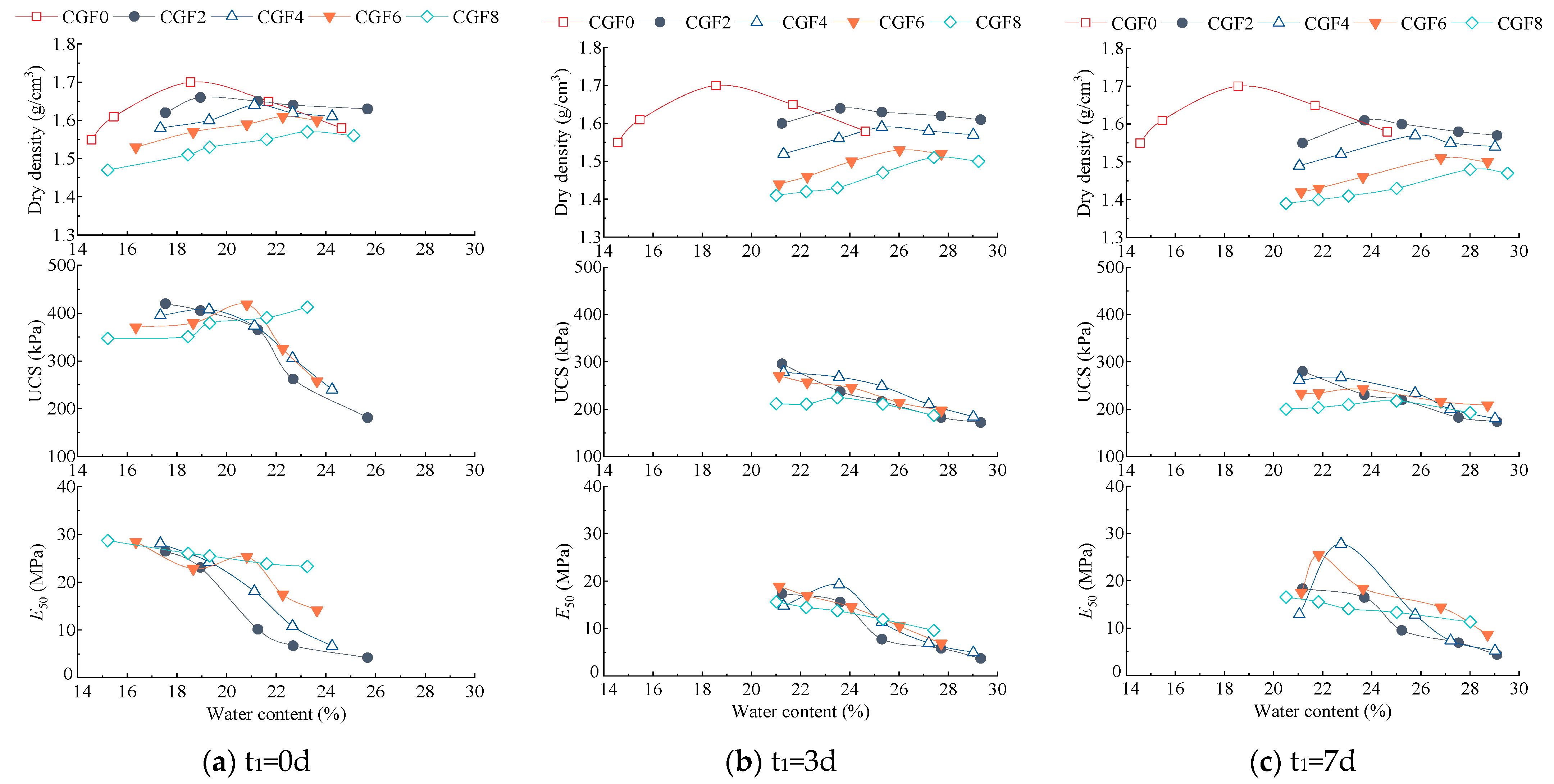


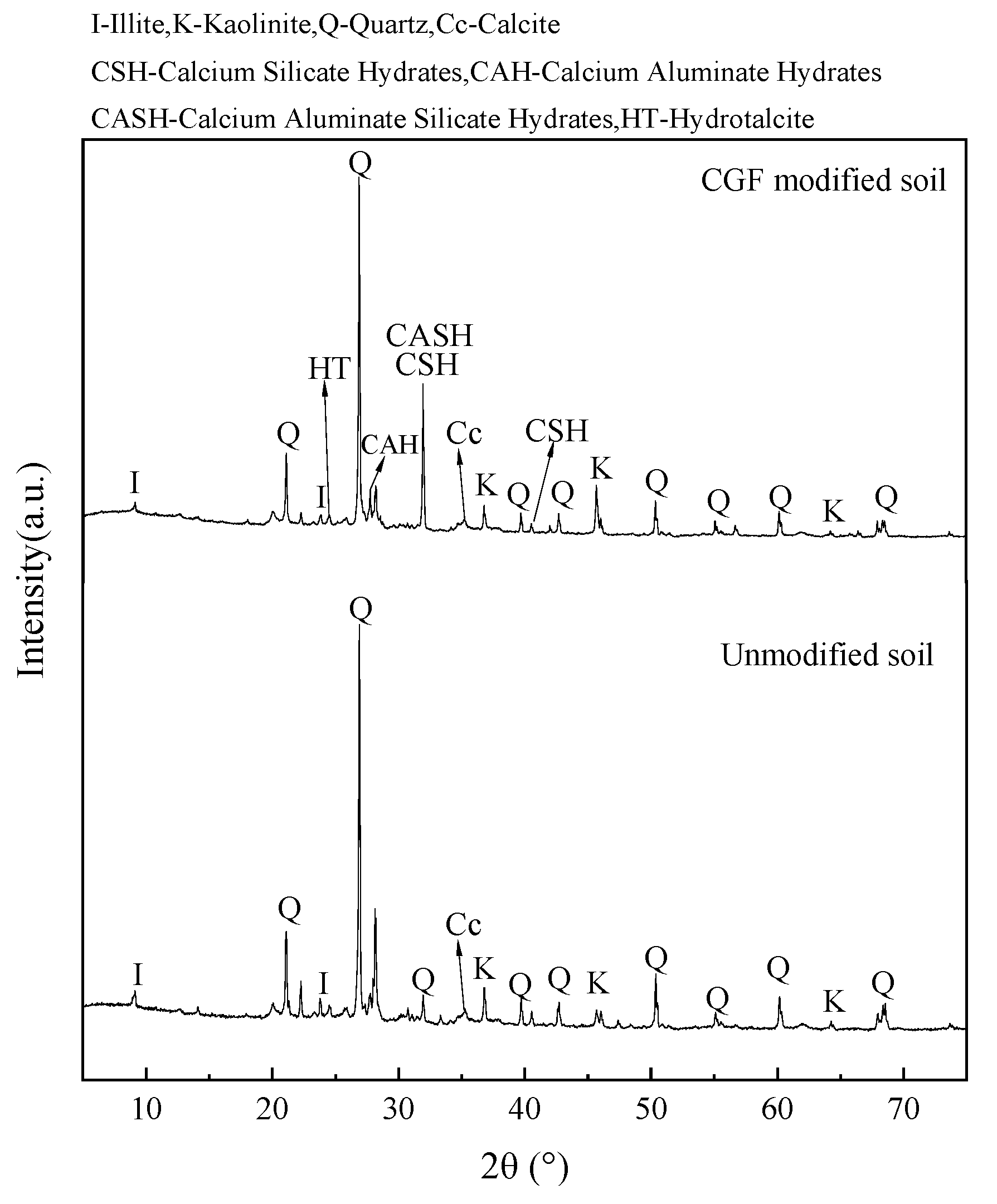
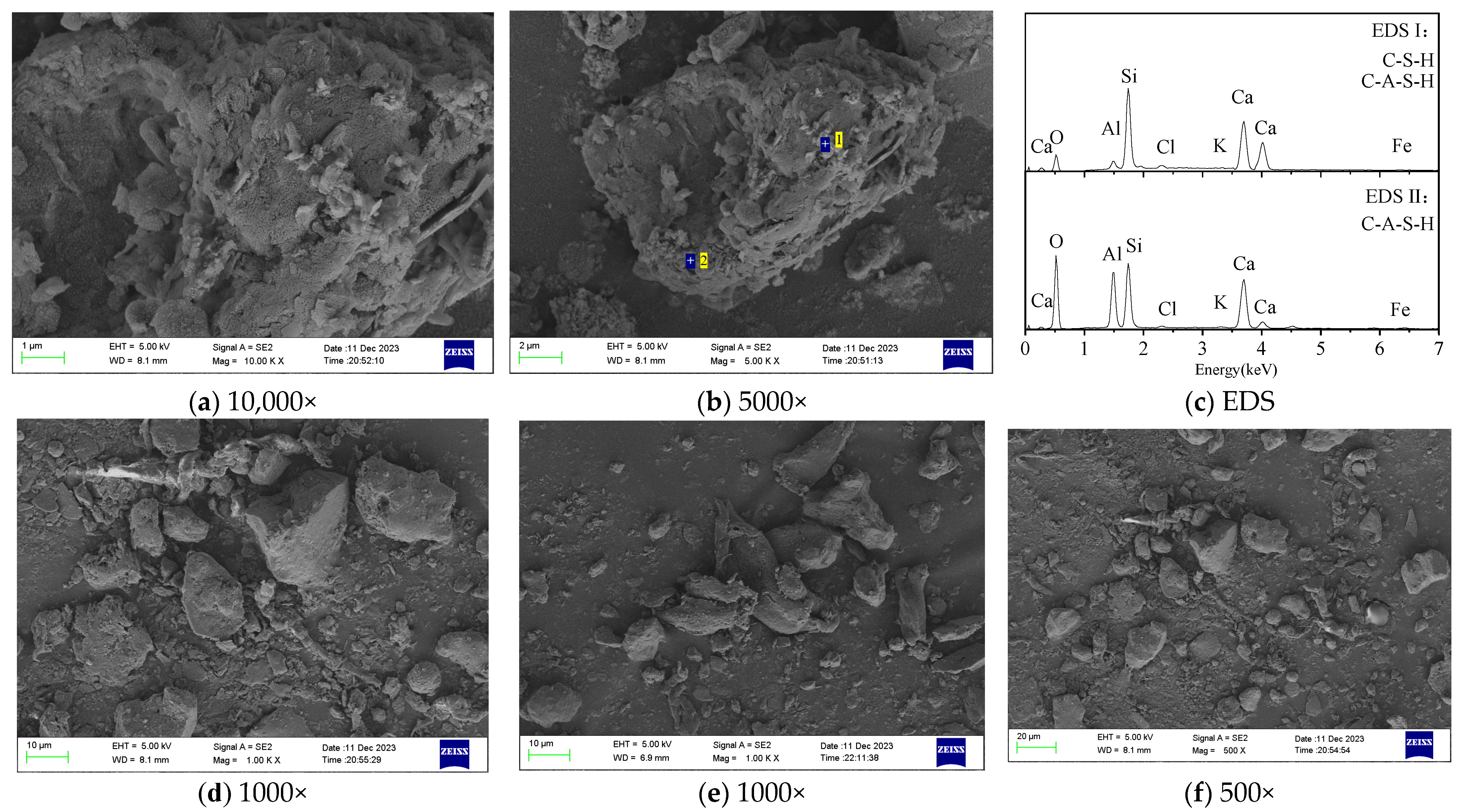
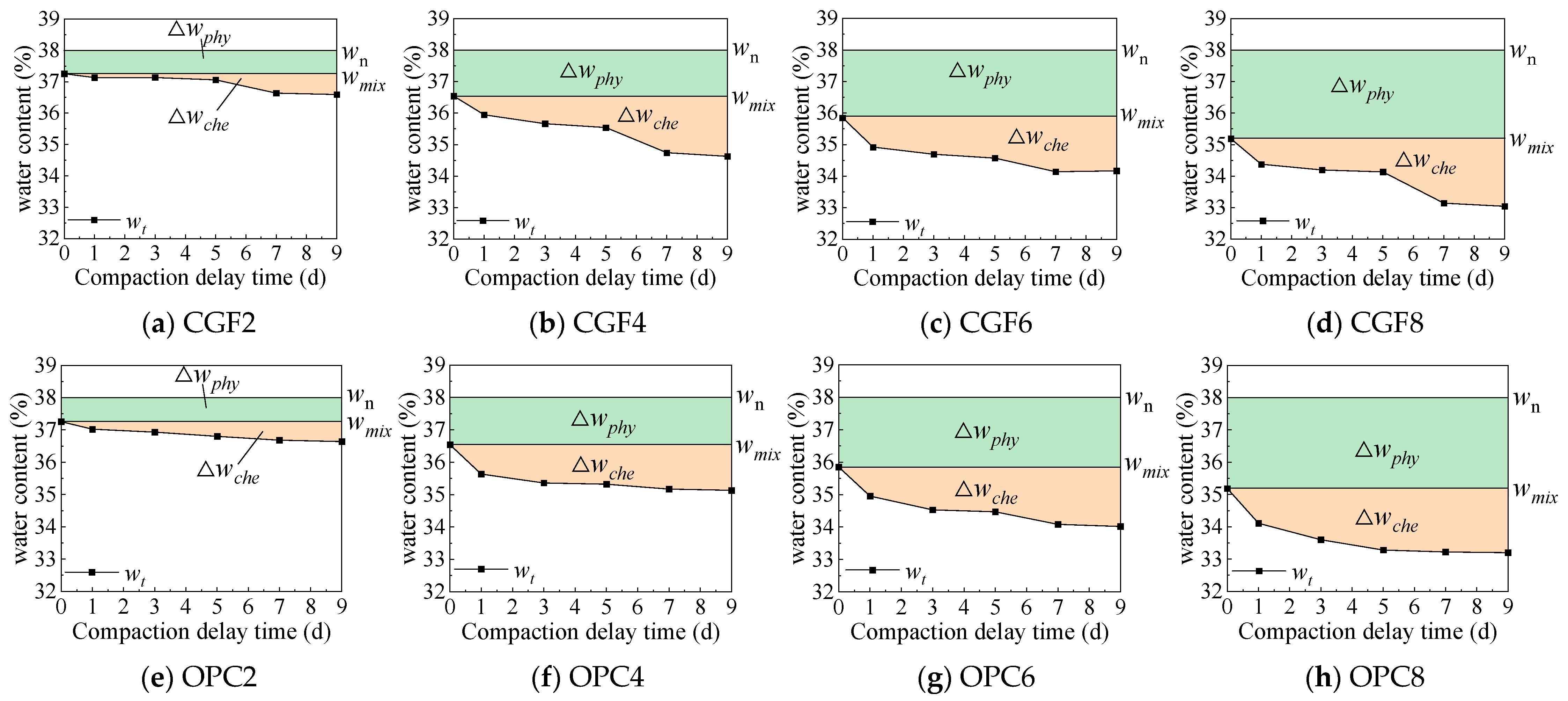
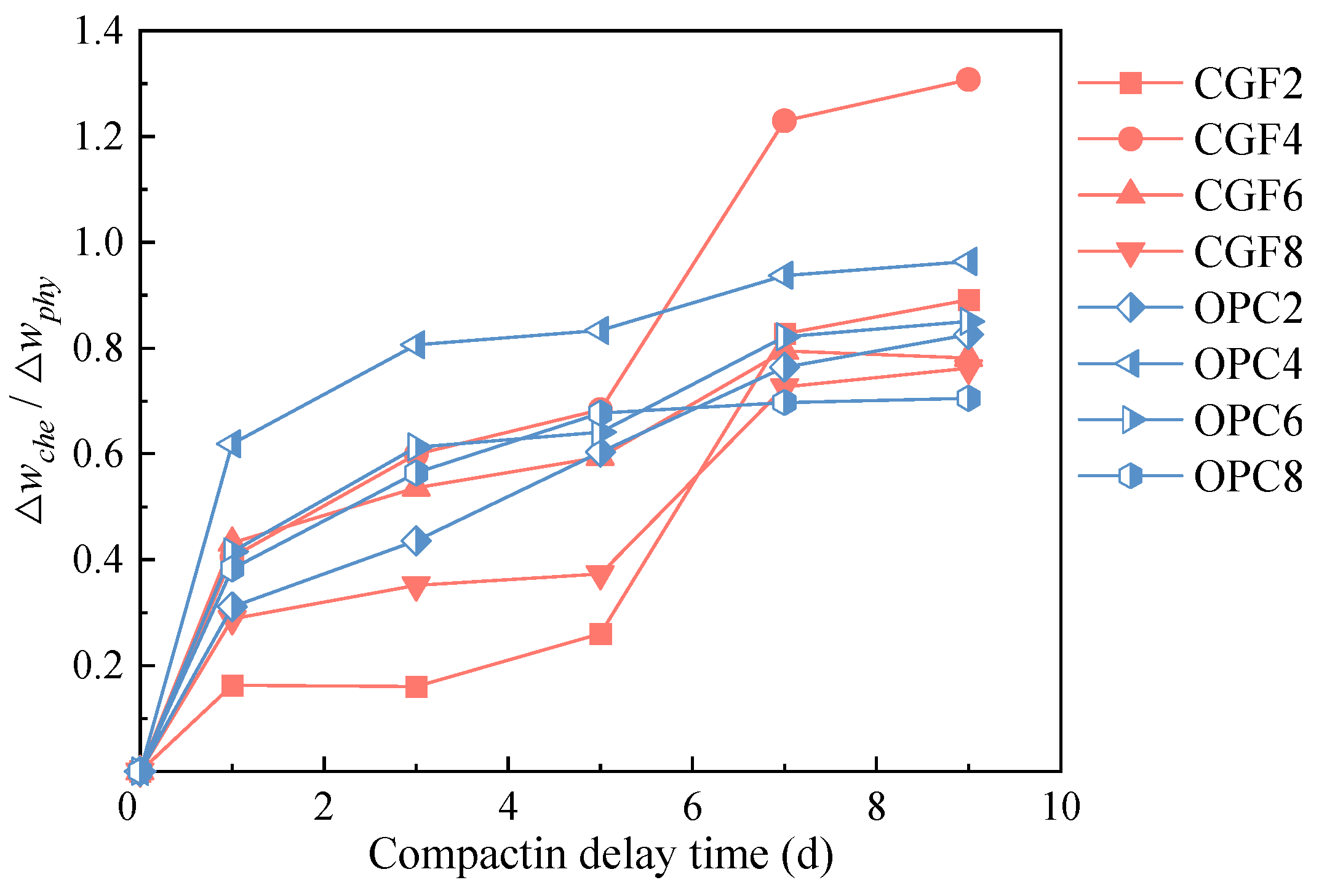
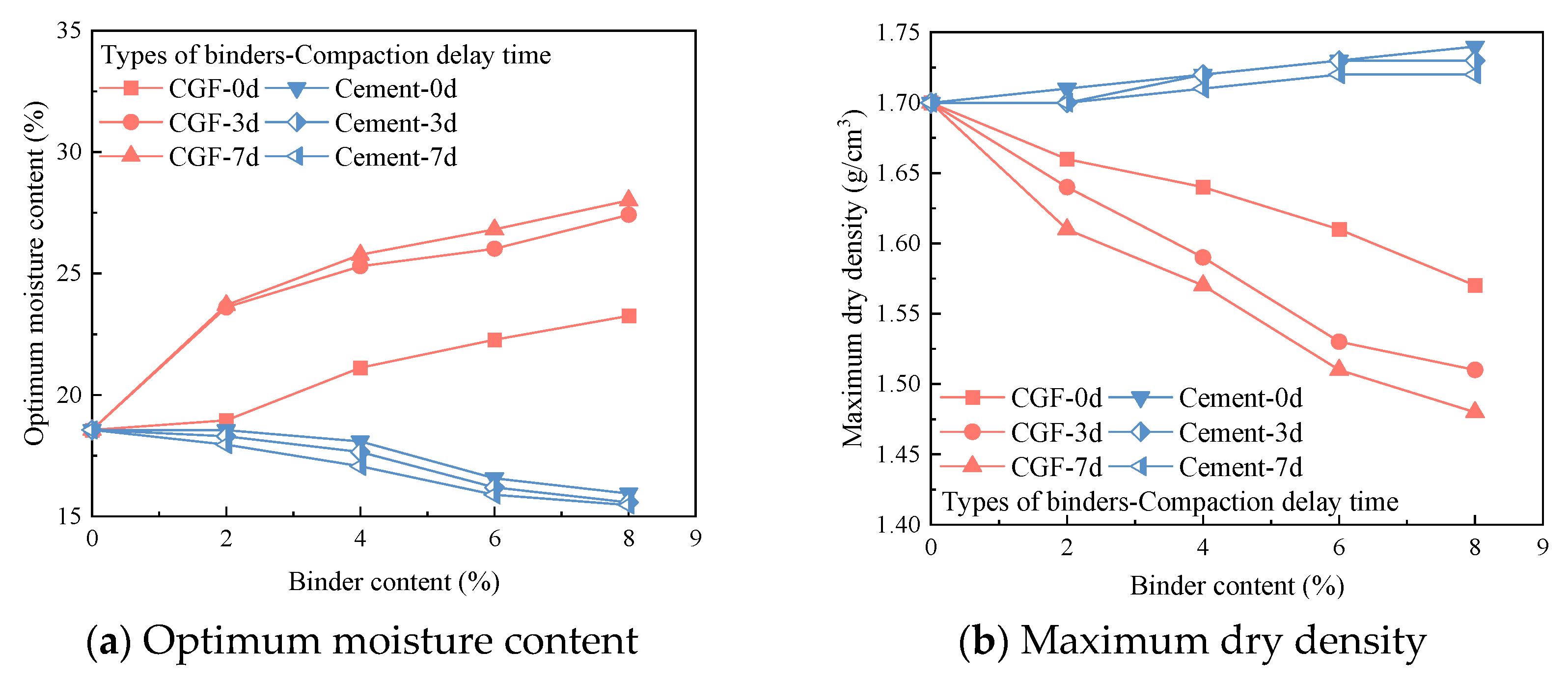
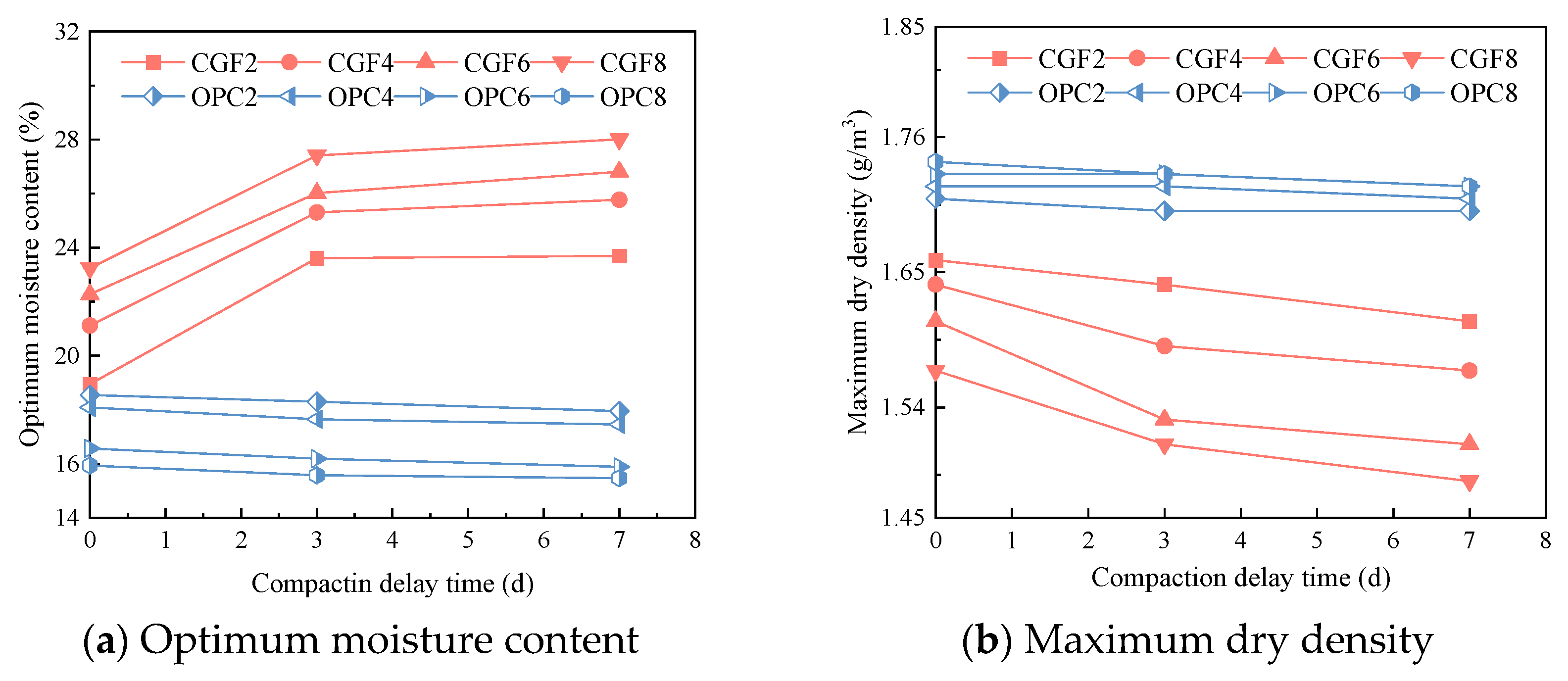

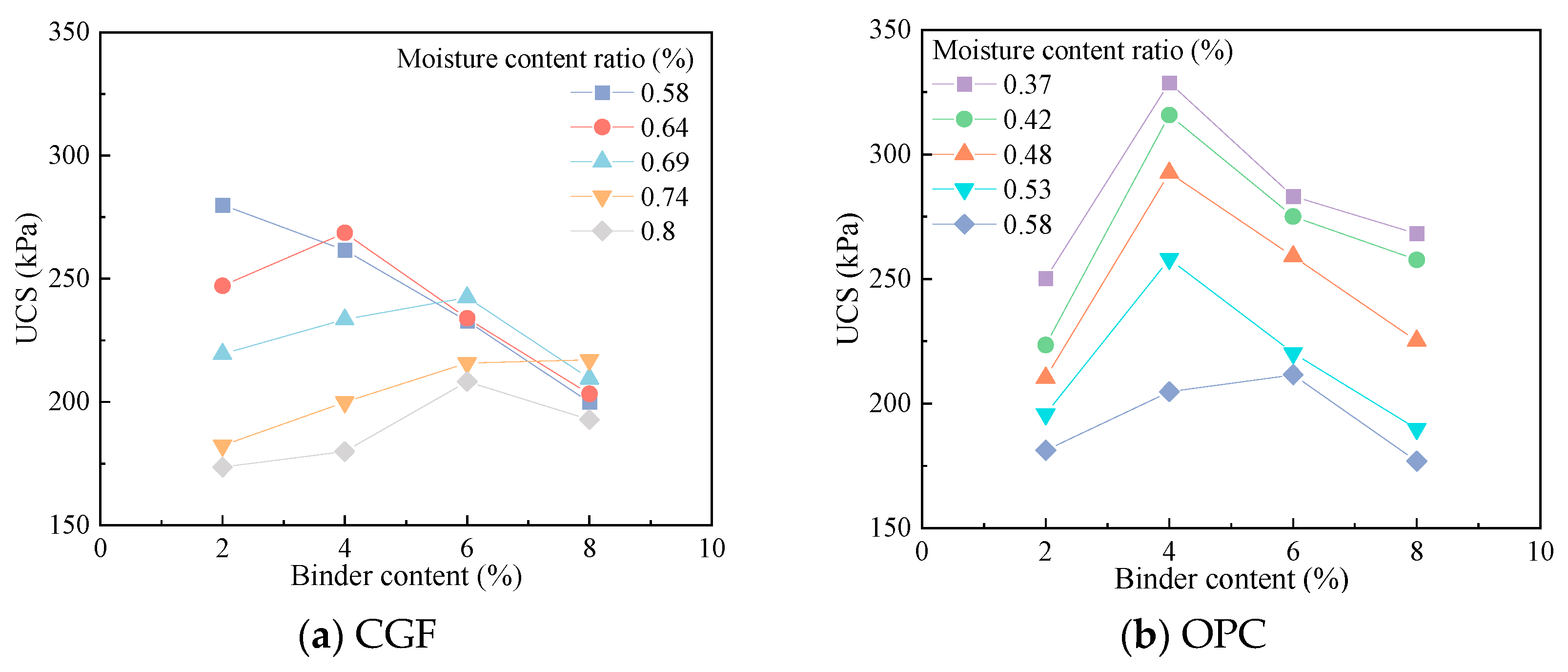
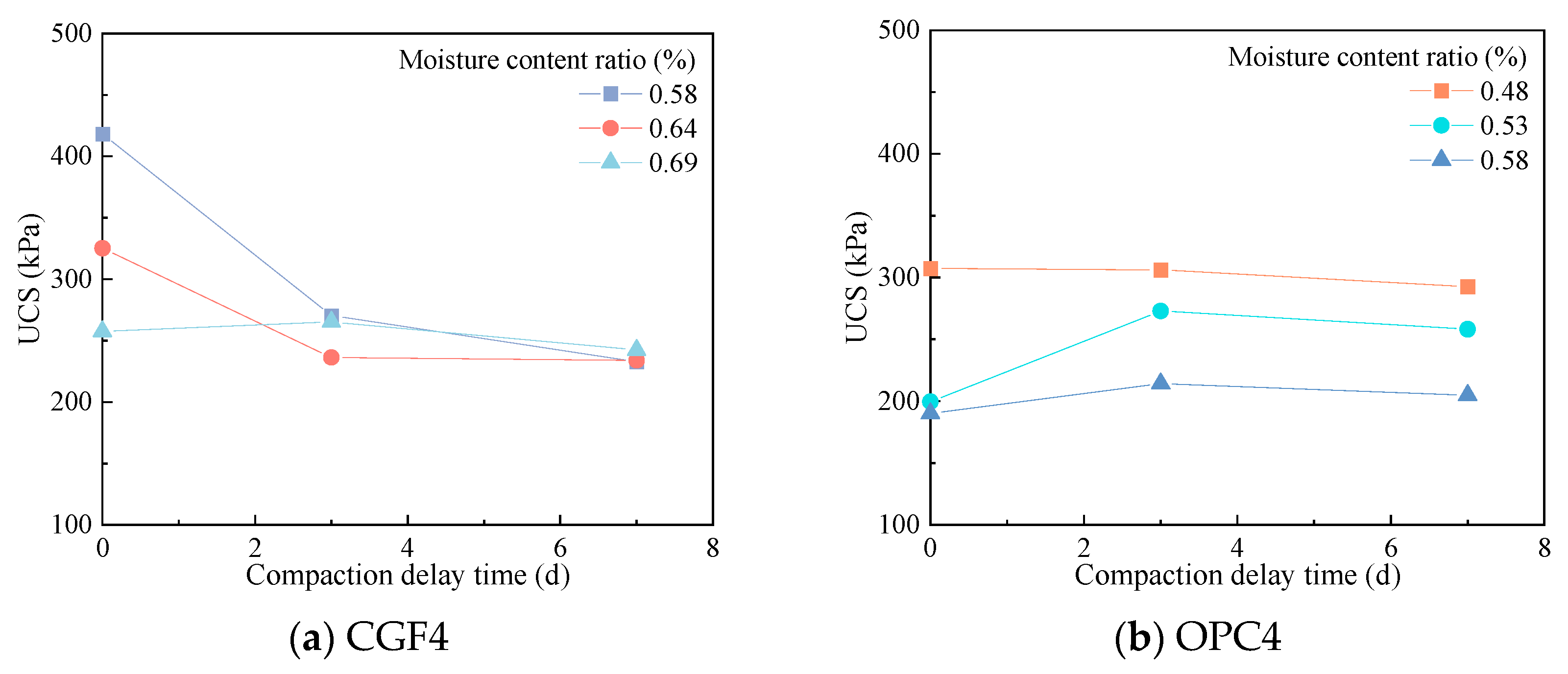

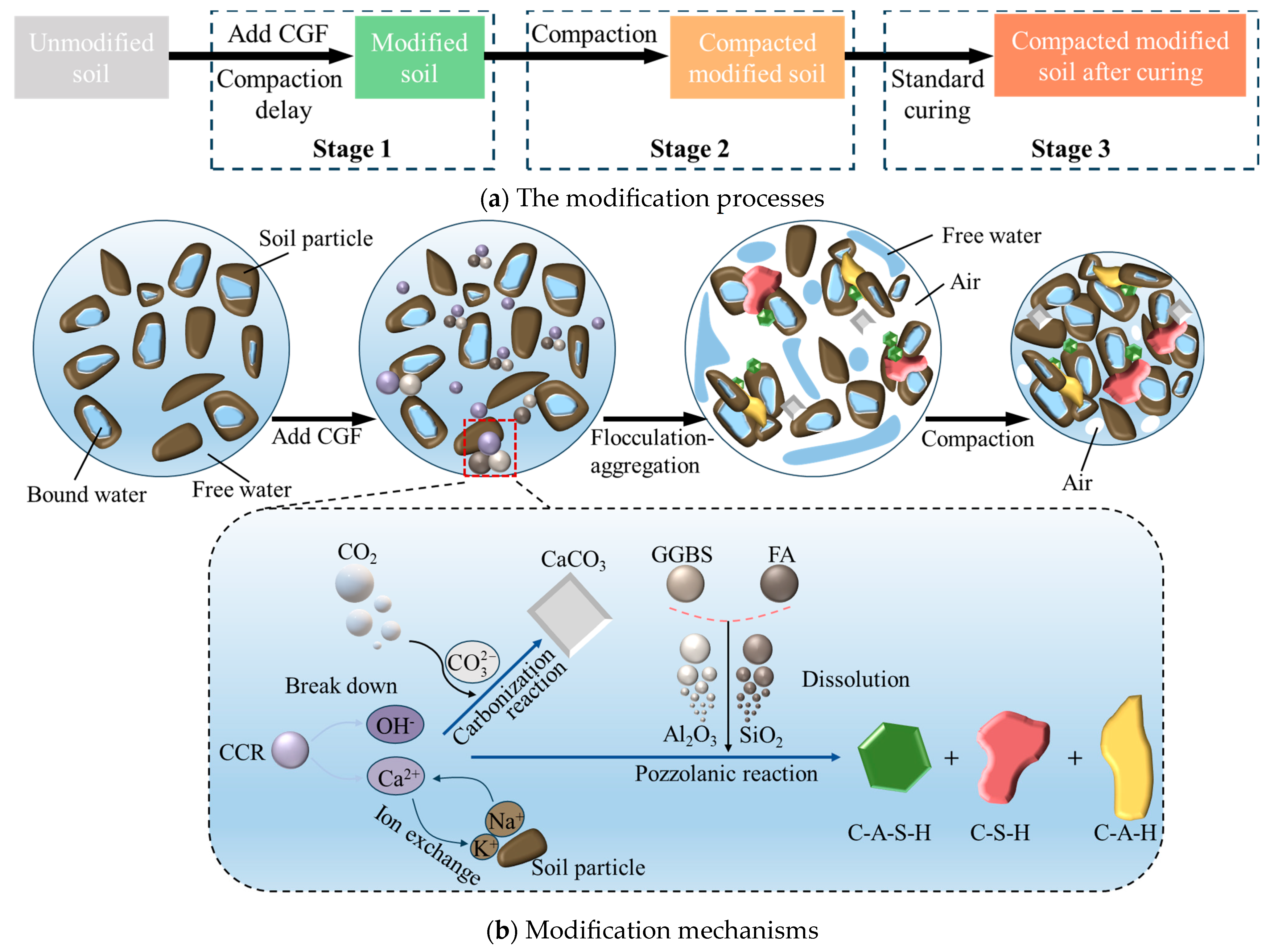

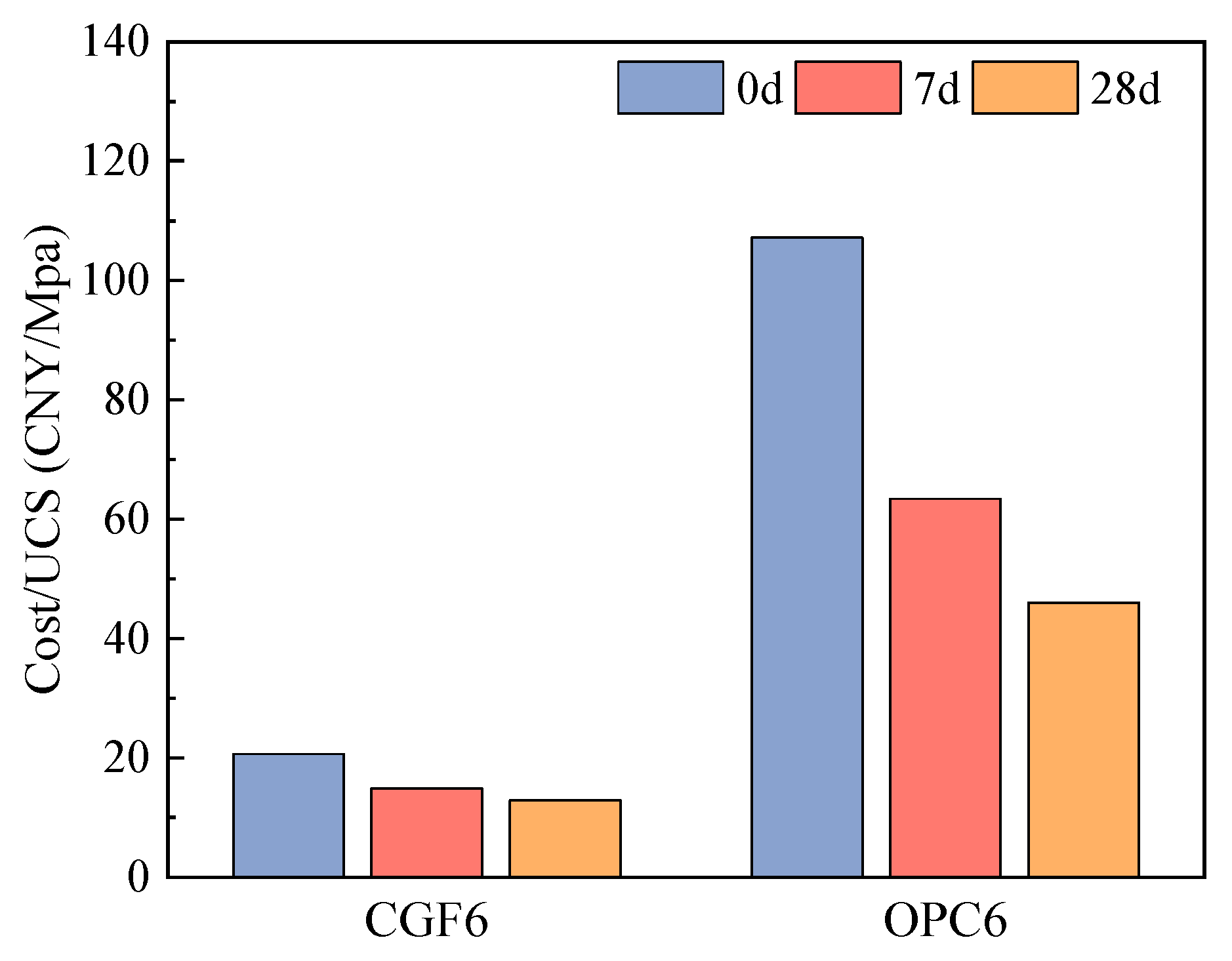
| Specific Gravity | Plastic Limit (%) | Liquid Limit (%) | Plasticity Index |
|---|---|---|---|
| 2.74 | 15.2 | 37.7 | 22.5 |
| Chemicals (%) | CaO | Al2O3 | SiO2 | MgO | Fe2O3 | Na2O | K2O | SO3 | P2O5 | Others |
|---|---|---|---|---|---|---|---|---|---|---|
| CCR | 68.80 | 1.56 | 3.59 | 1.21 | 0.09 | / | 0.03 | 0.75 | / | 23.97 |
| GGBS | 41.17 | 13.61 | 29.47 | 8.04 | 0.43 | 0.68 | 0.35 | 4.90 | 0.03 | 1.32 |
| FA | 6.60 | 12.66 | 61.29 | 0.02 | 4.48 | 3.75 | 1.32 | 0.66 | 0.01 | 9.21 |
| Test Soil | Initial Moisture Content Ratio, αwn | Types of Binder | Content of Binders, as (%) 2 | Compaction Delay Time, t1 (d) | Curing Time, t2 (d) | Tests |
|---|---|---|---|---|---|---|
| Jiaozhou bay marine soft soil | 1.0 | CGF, P.O 42.5 1 | 2, 4, 6, 8 | 0, 3, 7 | 0, 7, 28 | Water content tests, Atterberg limit tests, compaction tests, unconfined compressive strength tests, scanning electron microscopy (SEM), X-ray diffraction (XRD) |
Disclaimer/Publisher’s Note: The statements, opinions and data contained in all publications are solely those of the individual author(s) and contributor(s) and not of MDPI and/or the editor(s). MDPI and/or the editor(s) disclaim responsibility for any injury to people or property resulting from any ideas, methods, instructions or products referred to in the content. |
© 2024 by the authors. Licensee MDPI, Basel, Switzerland. This article is an open access article distributed under the terms and conditions of the Creative Commons Attribution (CC BY) license (https://creativecommons.org/licenses/by/4.0/).
Share and Cite
Liu, Q.; Yang, J.; Wu, Y.; Wang, Z.; Qiu, X.; Yan, L. Physical and Mechanical Properties of All-Solid-Waste-Based Binder-Modified Abandoned Marine Soft Soil. J. Mar. Sci. Eng. 2024, 12, 393. https://doi.org/10.3390/jmse12030393
Liu Q, Yang J, Wu Y, Wang Z, Qiu X, Yan L. Physical and Mechanical Properties of All-Solid-Waste-Based Binder-Modified Abandoned Marine Soft Soil. Journal of Marine Science and Engineering. 2024; 12(3):393. https://doi.org/10.3390/jmse12030393
Chicago/Turabian StyleLiu, Qiang, Junjie Yang, Yalei Wu, Zimou Wang, Xinyi Qiu, and Lijun Yan. 2024. "Physical and Mechanical Properties of All-Solid-Waste-Based Binder-Modified Abandoned Marine Soft Soil" Journal of Marine Science and Engineering 12, no. 3: 393. https://doi.org/10.3390/jmse12030393
APA StyleLiu, Q., Yang, J., Wu, Y., Wang, Z., Qiu, X., & Yan, L. (2024). Physical and Mechanical Properties of All-Solid-Waste-Based Binder-Modified Abandoned Marine Soft Soil. Journal of Marine Science and Engineering, 12(3), 393. https://doi.org/10.3390/jmse12030393





